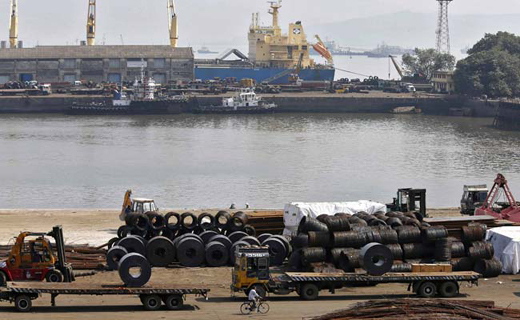In Space-Starved Mumbai, Big Plans for a Facelift
Mangalore Today News Network
Mumbai, Nov 19, 2014: The redevelopment of Mumbai’s mostly derelict docklands will, if a government-appointed panel has its way, create a waterfront where people living in the world’s second-most densely populated city can go to lift their spirits, and the rich can go to play.

"This is a real opportunity to give Mumbai what it doesn’t have, to give it open space," said Narinder Nayar, a businessman who sits on the panel, whose recommendations will be unveiled this week.
Owned by Mumbai Port Trust, the largest landowner in India’s financial hub, much of the seven square kilometres up for redevelopment is occupied today by crumbling warehouses, informal housing and workers who eke out a living breaking down disused ships or sorting through scrap metal.
The government, which has valued the land at $12 billion or around Rs. 742 crore, is pitching the project as a shining example of what urban regeneration in India should look like: transport minister Nitin Gadkari wants a giant ferris wheel similar to the London Eye.
"We should be looking towards the examples of New York, London, Sydney... Barcelona as well, to see what can be done with our former industrial areas on the waterfront," Mr Nayar said.
Whereas Mumbai’s western shoreline looks out to the Arabian Sea, this land is located on the protected eastern side of the city’s southern tip, affording a view across the harbour to the mainland, where a new deep-sea container port is based.
Mr Nayar says the panel will recommend that about 30 percent of the land be opened as public space with the construction of a hospital and affordable housing, linked by new train lines.
There are plans for a floating hotel and convention centre too, and a tender is already out to build a luxury marina to cater to the city’s super-rich.
With its natural harbour, Bombay, as it was called back then, was rapidly developed during British colonial times, and much of today’s city sits on reclaimed land that joined up a string of tiny islands off India’s western coast.
Mumbai hasn’t got a great track record for urban planning, however. Mounting demographic pressures and long delays for infrastructure projects have often meant that whatever progress takes place has already been overtaken by the population’s growing needs.
There are some 12.5 million people crammed on the ’island city’, a narrow wedge of land jutting into the sea, and around 21 million in the greater metropolitan area.
Residents and urban experts worry that the Mumbai port project will either fail to get off the ground, or succumb to the same unregulated building sprees seen across the country.
There was a plan in the 1990s to reserve a third of 2.4 square kilometres (0.9 square mile) of defunct mill land in central Mumbai for public space, and a third for affordable housing. It ended with most of the area sold privately and turned into luxury skyscrapers set amid landscaped gated gardens.
Courtesy: NDTV
- Missing Student Ran Away Over Exam Fear: Superintendent of Police
- Kasaragod: Missing Schoolgirl and Driver Found Dead in Merkala Forest After 26 Days
- The Intriguing Story Behind Diganth’s Mysterious Disappearance!
- Tamil Nadu CM M.K. Stalin’s Wife Visits Kollur Mookambika Temple
- Mangaluru Couple Completes Mumbai-to-Mangaluru Marathon, Eyes Guinness Record
- Eminent Aloysian Alumni Award 2025 Honors Five Achievers
- Udupi: Women Have Proved Their Strength in Every Field, Says Sri Sugunendra Thirtha Swami
- Missing II PUC Student Diganth found in Udupi after 10-day search
- Daylight burglary: Gold ornaments stolen from house in Vittal
- Illegal cattle transport: Three arrested after car crash near Gangolli
- District BJP stages protest; alleges injustice to DK in state budget
- Deputy Lokayukta inspects Varamballi waste unit, Kaup dumping yard
- Attempt to deactivate mobile jammers: Case filed against 9 prisoners
- Devotees Flock to Prayagraj’s Sangam Even After Maha Kumbh Ends
- India Condemns Vandalism at Hindu Temple in California, Calls for Strict Action
- Delhi CM Rekha Gupta-led cabinet approves ₹2,500 monthly aid for women
- After Ranya Rao’s arrest, CBI to probe international gold smuggling ring
- In a first, all-women crew runs Vande Bharat on International Women’s Day
- Elderly woman falls after wheelchair delay, Air India flags late arrival
- Jinnah must be happy with Siddaramaiah’s budget, says CT Ravi
- Chess star to Space scientist: Women achievers take over PM Modi’s X handle
- Two women, including Israeli tourist, raped near Hampi
- Over 140 killed in clashes between Syrian forces and Assad loyalists
- Actor Ranya Rao admits to role in gold smuggling; DRI gets 3-day custody
- Relief for Siddaramaiah’s wife in MUDA case, probe agency summons cancelled
- Court remands Maoist Lakshmi to six-day police custody
- Sandhya Shenoy honored with Society for Materials Chemistry Medal-2024
- White Cornus Apartment in Mangaluru
- City girl wins first place in state-level spell bee competition
- Alleged ‘Love Jihad’ Case in Mangaluru: Woman left home voluntarily, says police
- Girl fatally struck by reckless two-wheeler near Belman
- New residential complex for the judges inaugurated in Mangaluru
- Absconding accused nabbed after 8 years
- Truck with cylinders turns turtle in Beltangady
- Bhoota Kola artist dies of cardiac arrest
- Development of the country should be our goal: Ganesh Karnik
- Container truck gets stuck under Modankap railway bridge
- Truck crushes bike’s pillion rider near BC Road
- Head constable dies of heart attack
- Udupi: PDO dismissed over financial irregularities
- CITY INFORMATION
- TRAVEL
- TOURIST INFORMATION
- HEALTH CARE
- MISCELLANEOUS




 Write Comment
Write Comment E-Mail To a Friend
E-Mail To a Friend Facebook
Facebook Twitter
Twitter  Print
Print 




